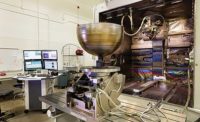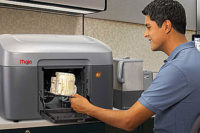The marathon, a race of 26.2 miles, is always a challenge for Maximilian Peter, Ph.D., a process engineer at Wacker Chemie. Besides being physically fit, it’s also necessary to have the right gear, in particular well-fitting running shoes. That gave him an idea: shock-absorbing insoles, custom-made to conform to his feet. “There’s nothing like that available yet,” says Peter.
So, together with his colleagues at Wacker Silicones and engineers at Enders Ingenieure GmbH, a product development and prototyping company based in southern Germany, Peter developed a solution: 3D printing of silicone.
“Until now, it had been impossible to print elastomers or rubbery materials. There were just no suitable processes,” explains Bernd Pachaly, Ph.D., head of silicones research at Wacker Silicones.
Traditionally, silicone parts are produced by injection molding. However, because of the costs of custom-making the molds, the process is only worthwhile for large production runs—not for a single pair of insoles.
“Injection molding is the established process for series production, and will remain so,” says Pachaly. “But people who design prototypes or who only want to make a few copies of a part can now very rapidly and flexibly produce such small series, modifying them constantly to meet changing demands. That is the unique advantage of the 3D printing process.”
With this new technology, silicone joins a growing list of materials for additive manufacturing, including ABS, polycarbonate, nylon, stainless steel, titanium and ceramics.
A New Approach
From the outset, it was clear that 3D printing of silicone would require a fundamentally new approach.
Silicone is not melted by heat in the same way as thermoplastics or metals. It cannot be applied layer by layer as a powder, and melted by laser beam to the desired three-dimensional shape.
Instead, Peter and his development team developed a system involving high-speed dispensing and robotics. The process took approximately a year develop.
The system consists of a Cartesian robot equipped with a dispensing nozzle that rapidly deposits one droplet of silicone at a time on a base surface. Just like inkjet printing on paper, the robot follows a path governed by a CAD file of the part.
The developers couldn’t use off-the-shelf software to control the robot. “A key step in the development work was to write a custom program,” says Florian Ganz, CEO of Enders.
“It is the first really user-friendly software in this field,” adds Pachaly.
The robot regularly pauses and a beam of ultraviolet light scans over the tiny drops, which have merged into a fine line. The UV light vulcanizes the silicone then in less than a second, crosslinking the molecules into an elastomeric material. The robot then applies the next layer of silicone droplets.
Thanks to the vulcanization, a homogeneous object is formed. Once it’s applied, the viscous material immediately bonds to the layers adjacent to or below it.
The process doesn’t take very long. After 15 minutes, the device can print a small part approximately 1 centimeter wide and several millimeters thick. Eventually, the developers expect the machine to be able to process about 100 grams of silicone per hour—fast enough for any conceivable application.
Since the structures generated by the robot are extremely fine, the precision is impressive. With each pass, the nozzle can dispense a silicone strip approximately 0.6 millimeter wide and 0.3 millimeter thick. That makes it possible to produce precise contours and results in a surface that is almost smooth and is pleasant to the touch.
“The roughness may be even better than 100 microns,” says Pachaly. That is hardly a hair’s breadth, and significantly smoother than printed thermoplastics.
The pieces look almost like injection moldings rather than parts made by additive manufacturing. To achieve that, Ernst Selbertinger, Ph.D., a silicone developer at Wacker, had to create a formulation that could be dosed as tiny liquid droplets that immediately remain stationary at the place they were deposited.
“Think of toothpaste. It flows under pressure as you squeeze it from the tube, but it is firm when on the brush,” explains Selbertinger.
Besides being formulated for 3D printing, the silicone contains a platinum catalyst that is responsible for crosslinking the molecules under UV light.
3D Printing Applications
Pachaly sees immediate applications for the technology in the
automotive industry. Because 3D printing is much faster than conventional technologies for manufacturing small runs and one-off articles, Pachaly expects the technology to be used to make prototypes and spare parts for various silicone car parts, such as plugs and hoses. “In the auto sector, it will no longer be necessary to keep costly and complex stocks of silicone parts,” he says.
The medical sector is also interested in the material for its biocompatibility. For example, implants could be custom-made for the patient—even during an operation—based on data provided by technologies such as magnetic resonance imaging.
Custom-made silicone respirator masks and hearing aids will soon be manufactured by 3D printing. And, every wearer of eyeglasses will welcome nose pads that really fit. The optician will only need to scan the three-dimensional contour of the nose and send the data to a 3D printer, which will then produce a perfectly fitting pad.
In the home, it will be possible to produce baking molds in any conceivable shape. Silicone is famously heat resistant. Because it is also valued for its transparency, the researchers are also devising optical applications, such as lenses printed to order. And last but not least, the researchers believe the technology can be used to make individually tailored insoles for running shoes.
“We have a lot of ideas, and we want to provide our customers with much more than just silicone for additive manufacturing,” says Pachaly.








